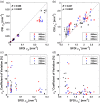Quantifying tissue properties and absolute hemodynamics using coherent spatial imaging
- PMID: 38116026
- PMCID: PMC10730023
- DOI: 10.1117/1.JBO.28.12.127001
Quantifying tissue properties and absolute hemodynamics using coherent spatial imaging
Abstract
Significance: Measuring hemodynamic function is crucial for health assessment. Optical signals provide relative hemoglobin concentration changes, but absolute measurements require costly, bulky technology. Speckleplethysmography (SPG) uses coherent light to detect speckle fluctuations. Combining SPG with multispectral measurements may provide important physiological information on blood flow and absolute hemoglobin concentration.
Aim: To develop an affordable optical technology to measure tissue absorption, scattering, hemoglobin concentrations, tissue oxygen saturation (), and blood flow.
Approach: We integrated reflectance spectroscopy and laser speckle imaging to create coherent spatial imaging (CSI). CSI was validated against spatial frequency domain imaging (SFDI) using phantom-based measurements. In vivo arterial and venous occlusion experiments compared CSI with diffuse optical spectroscopy/diffuse correlation spectroscopy (DOS/DCS) measurements.
Results: CSI and SFDI agreed on tissue absorption and scattering in phantom tests. CSI and DOS/DCS showed similar trends and agreement in arterial occlusion results. During venous occlusion, both uncorrected and corrected blood flow decreased with increasing pressure, with an difference in overall blood flow decrease between the methods. CSI and DOS/DCS data showed expected hemoglobin concentrations, , and blood flow trends.
Conclusions: CSI provides affordable and comprehensive hemodynamic information. It can potentially detect dysfunction and improve measurements, such as blood pressure, , and metabolism.
Keywords: blood flow; diffuse optics; hemoglobin concentrations; optical properties.
© 2023 The Authors.
Figures






